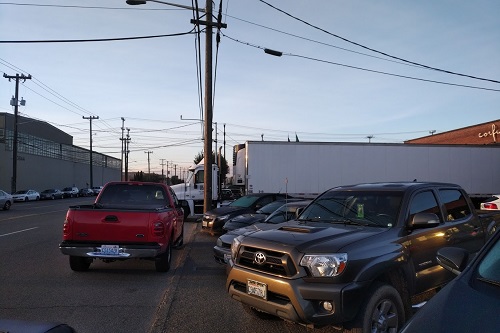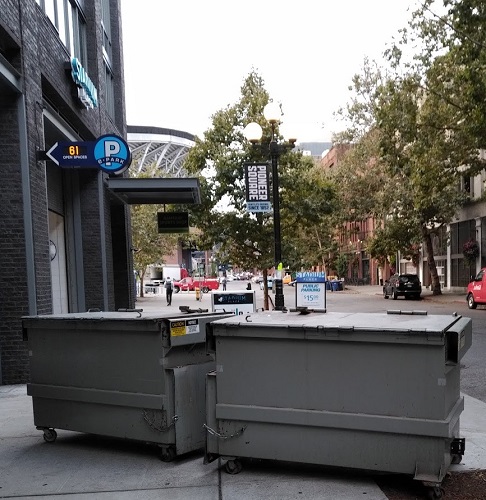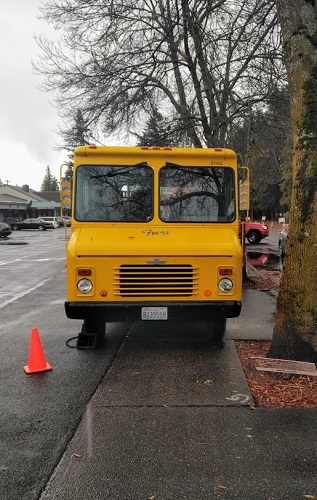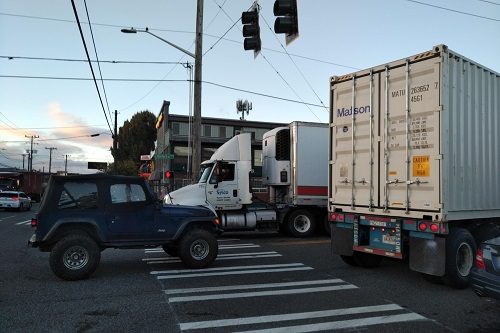It’s 7:30am on a weekday. I’m jogging along 1st Avenue from downtown into Pioneer Square on my way to SoDo. As I make my way to an intersection, I run into an enormous, moving excavator with its bucket slamming down into pavement right in front of me. There were no signs. Next thing I know, a police officer is yelling at me, waving his arms wildly, and pointing me to the other side of the road.
Where were the signs that the crosswalk was closed? That the sidewalk would be interrupted? That I was entering a construction zone? They didn’t exist.
This was not the first time I’d wandered into an active construction site in the pedestrian right-of-way. Once I ran into a gigantic hole in the ground while jogging on Dexter Avenue. Again, there’d been no signs or warnings of this peril.
Some years ago, in a ridiculous column in The Seattle Times, Briar Dudley stated, “Seattle can no longer deny it’s engaged in a war on cars.” This jumpstarted a long, mostly absurd community discussion about whether our city is engaging in a campaign against automobiles. It goes on (mostly in comments sections) to this day. All the while, most of our infrastructure and resources are devoted to cars–the most recent SDOT budget is decidedly car-centric.
Considering my experiences, how much money we devote to pedestrian safety (it’s embarrassingly small), and troubling trend of increasing numbers of pedestrians being run over and killed by motorists each year, it seems the real ‘war’ is against pedestrians.
According to WSDOT, 109 pedestrians were killed in 2017 on Washington’s streets–an intolerable 118 percent increase in five years. Pedestrian and cyclist fatalities make up 22 percent of all traffic deaths in our state–nearly a fourth and yet…
There are swaths of major arterials that are effectively unusable for people on foot–James Street (First Hill to downtown), Sand Point Way, Edgar Martinez Drive, Occidental Avenue, and on and on. There are no sidewalks or limited sidewalks that just end. As a pedestrian, you must wait five to six minutes to cross Mercer (and several other streets) and then, you’re given 30 seconds to cross eight lanes of traffic. If you aren’t there right when it changes from red hand to walk, you won’t make it across. There are miles of 1st Avenue in SoDo without crosswalks or a way for a pedestrian to get across the street. On Aurora, up by N 130th St and other areas, if you live in apartment across the street from a grocery store, you must walk nearly mile to find a crosswalk (and then a mile back) to get across.

At one point earlier this year, I had to cross back and forth on Dexter four times to get down to my favorite lunch spot less than half a mile away because of construction. Around that same time, there was no way for pedestrian to head west on Denny Way from the freeway to South Lake Union–sidewalks were closed because of multiple construction sites. Not only that, if you then walked north to try to find a different street, the next three blocks were also impassable–with no signage sharing this information.
I’ve spent almost 20 years working all over Seattle–from up in Fremont to down in SoDo, from South Lake Union to downtown, from Rainier Valley to Northgate. The one, unified aspect of my commute (I run, walk, cycle, drive and take public transit) is how horrible it is to be a pedestrian. From maintenance crews closing a sidewalk without considering how it will affect pedestrians, to garbage trucks making a sidewalk impassable with a wall of enormous containers, to delivery vehicles and Uber drivers parking across pedestrian pathways (and bike lanes), to shoddy infrastructure that can just end without warning, to parked cars and trucks being allowed to invade pedestrian spaces.

And this doesn’t even begin to address how our transportation system undervalues pedestrians. Walk along any street in Seattle and you’ll have to stop at every light and wait–lights are timed for cars. Don’t forget to click the walk button or when the light turns green, you won’t get a walk signal. Make sure you are there, present, waiting for the light to change or you won’t have time to cross. And make sure you are focused and diligent about your own safety because there will inevitably be a few cars that run the light, a driver surging forward for that “free right-hand turn”, or a frantic commuter trying to make the left-hand turn between oncoming traffic. There may be a bus turning, blocking two crosswalks and forcing pedestrians out into traffic, a distracted driver who hasn’t bothered to look up and flies through a red light, or an instant parking lot of cars blocking your crosswalk.

If you spend any time on foot in our city, you’re faced with inconveniences, dangerous situations, and a lack of pedestrian infrastructure.
And no one seems to care. Even though we all become pedestrians at some point, neither City officials nor private citizens devote much time to the concerns of people walking. There are numerous arterials all over the city that don’t have sidewalks, numerous intersections without crosswalks, and several outlying areas (Wedgwood, Broadview, Crown Hill, etc.) that have never had sidewalks (and may never have them at our sidewalk construction pace). From 2013 to 2017, 62 percent of fatal and serious injuries involving pedestrians and cyclists were on our city streets.
Our infrastructure is not only so focused on cars it puts pedestrians in danger, it’s designed to focus on driver convenience and it’s pretty much setup so they can cheat. Just a few weeks ago, I wanted to cross Yesler Way to go to Occidental Ave South. There are two crosswalks with stop signs for cars. A commuter in a blue SUV blew through the stop sign and nearly hit me. He had the gall to stop and yell at me because he “hadn’t seen me”. First, this was a preposterous statement; he couldn’t have seen anyone because he didn’t come to a stop. Second, he knew he didn’t need to stop, he could bully the pedestrians into staying on the curb and letting him pass.
This is a prime example of the infrastructure not only failing pedestrians, but also helping drivers get away with ignoring laws. If you are pedestrian waiting to cross a mid-street crosswalk, you have to show initiative to get drivers to stop – most will just drive right by. I’ve had drivers swerve around me while I’m crossing. And when I’ve stopped in my car for pedestrians, I’ve had drivers honk and go around me, nearly hitting people. These and other crosswalks offer no support or protection for pedestrians. Many are located on streets with speed limits around 35 miles per hour (meaning people are going 40-45 miles per hour), so even if the crosswalk is lit up like the New Year’s Eve fireworks show, you’re wearing reflective gear, and waving madly one of those stupid orange flags, they can’t stop for you safely and odds are they aren’t going to anyway. (WSDOT statistics indicate speed is the number one reason for pedestrian fatalities.)
Many side streets feed into arterials in dangerous ways. Drivers must pull halfway onto the arterial before they can see if there’s any cars coming (due to parked cars, the street alignment, and other factors). This is very dangerous for pedestrians since cars not only cross your space but also focus their attention away from you and on oncoming traffic to merge. And, most don’t have any markings to convey the pedestrian has the right-of-way.
Once I was walking along a major arterial about midway across an adjoining side street when a car came flying up to take a right-hand turn. The driver was looking left to see if she could jet out on to the arterial. As she came up the hill, she hit the gas, and then, seeing me, slammed on her brakes. She then proceeded to roll down her window and inform me that she was “a good driver” because she “didn’t hit me”. The only reason she didn’t hit me was her brakes were good. She hadn’t been looking the direction her car was going–the exact opposite of a good driver.
Much of these issues are caused by drivers either not understanding basic right-of-way laws or ignoring them. I’ve seen police cars parked in crosswalks and had a fire truck block a crosswalk with a walk signal because they decided to take the turn prematurely. The other day I watched as a motorcyclist with “traffic police” emblazoned all over his coat and his bike force several pedestrians walking along a busy sidewalk in downtown Seattle to stop so he could pull in to an empty parking lot. This and other factors embolden drives to just keep bullying their way around.
But there’s no reason things need to be like this. We can make pedestrians safer. We can make improvements (we have the design and engineering and studies) that protect and support pedestrians (and encourage them) without having significant, drastic changes to driving (35th Ave SW, Rainier Avenue and NE 75th Street are proof). If we can spend billions of dollars to help people move along in their single-occupancy-vehicles along major channels (places like Mercer), we can make more intersections pedestrian friendly. Extending out curb bulbs, paving pattern changes, bike lanes, speed bumps and elevation changes, widening sidewalks, reducing lane sizes, planting trees, and clearer signalization are a few ways that have been shown to make walking safer and more enjoyable.
This, along with improving education about traffic and right-of-way laws, and revising how we train people to look at intersections–it’s not just four lanes coming together. It’s those four driving lanes, plus bike lanes and pedestrian lanes. So, every time you cross a lane, you’re actually crossing three or four lanes.
We need the state, regional and local authorities to start considering the needs of pedestrians and enforcing existing laws and rules to protect walkable places. We need a mandate to make our streets focused on pedestrians as much as they are on automobiles. We need traffic police to ticket belligerent drivers and governing agencies to go after businesses and construction sites.
Then, maybe it won’t seem like Seattle doesn’t care about pedestrians. Until then, watch out!

Chris Priest
Chris Priest is a writer and community advocate who lives in northeast Seattle. Chris is a founding member of Safe 35th--a community-based group focused on bringing planned and agreed upon safety improvements to 35th Avenue NE in the Wedgwood, Ravenna and Bryant neighborhoods. He is a frequent cyclist, runner, transit rider, and walker who believes safe, inclusive modes of transportation are the way of the future.


